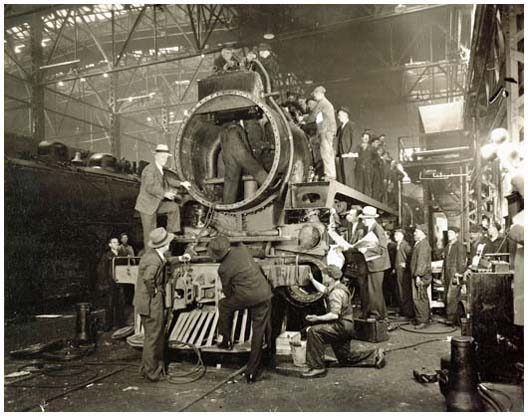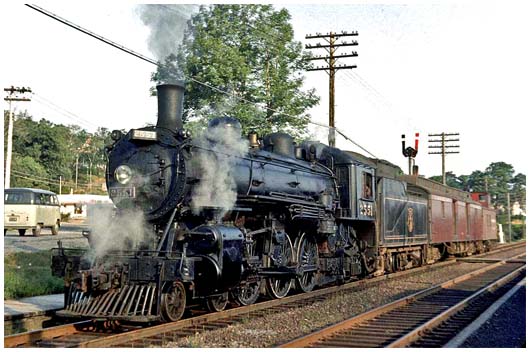
RECONDITIONING OF LOCOMOTIVES
By J.R. Macken
Supervisor of Costs and Labour Schedules in the
Office of the Chief of Motive Power and
Rolling Stock

Inside the Angus Shops - 1 Feb 1944 Photographer unknown.
 Introduction Many years ago Canadian Pacific published a series of ten books named the "Foundation Library". One particular book
added to this collection, published in 1946, is named "Canadian Pacific Facts and Figures". It contains many short stories and articles
dealing with the company during that period. This month's article from that book, "Types of Locomotives", written by J.R. Macken
Supervisor of Costs and Labour Schedules in the Office of the Chief of Motive Power and Rolling Stock, is reprinted here for your enlightenment
with the addition of some appropriate images.
 The 1946 Article The steam locomotive has a working life of from 30 to 40 years. This span of life is determined
by the boiler as all other parts are renewable, and through periodical inspections and general repairs locomotives are maintained in safe and
serviceable condition for the life of the boiler. The longevity of the active period of a locomotive contrasts remarkably with the comparatively
brief life of some other forms of motive power.
Even in the early stages of the design of a locomotive, careful attention is given to the arrangement, location, and construction
of each detail, to the end that accessibility and facilities for renewal of wearing parts may be provided.
It is the purpose of this article to outline the procedure by which the re-conditioning of a locomotive is effected.
 Selection of Locomotive for Shopping The selection of a locomotive for shopping is determined by several considerations, of which the factors are the mileage
accumulated since previous general repairs, condition of boiler and firebox, date of next internal inspection and tests, condition of machinery,
and operating requirements which may demand specific classes of power. Accumulated mileage since the previous general repair may be varied in the
case of individual locomotives but in general a passenger locomotive would average, between shoppings, 125,000 miles, a freight locomotive 80,000
miles, a switching locomotive 65,000 miles. The locomotive foreman of the roundhouse at which an engine is maintained, has a record of the mileage
made by each locomotive, with a general summary of its condition, particularly as regards boiler tubes and firebox, machinery and tires. His
recommendations, being transmitted to the division and district master mechanics, are used as a basis for the preparation of shopping lists,
covering the engines which it is proposed to shop. These lists, made up each month, cover a period of three months in advance. They are then
forwarded to the Superintendent of Motive Power, who makes the final decision as to which engines will be recommended for
shopping.
 Assuming the repairs will be made at Angus Shops for Eastern
Lines locomotives. A work report is submitted to cover the necessary visible repairs required and authority is given by the Chief of Motive Power
and Rolling Stock for the movement of the locomotive to the shop. Upon arrival at Angus examination of locomotive is made and an estimate is
submitted to the Chief of Motive Power and Rolling Stock, giving particulars of the necessary repairs and the estimated cost to complete same. Assuming the repairs will be made at Angus Shops for Eastern
Lines locomotives. A work report is submitted to cover the necessary visible repairs required and authority is given by the Chief of Motive Power
and Rolling Stock for the movement of the locomotive to the shop. Upon arrival at Angus examination of locomotive is made and an estimate is
submitted to the Chief of Motive Power and Rolling Stock, giving particulars of the necessary repairs and the estimated cost to complete same.
 Preparation of Locomotives and Repair The first operation is to place the locomotive on a coaling pit. Any coal remaining in the tender is removed, grates cleaned,
ashes dumped, fire brick arch removed from firebox, and all water drained from the boiler and tender.
From the coaling pit the engine is moved to the shot blast house, where any pitted and scaled paint surfaces are thoroughly
cleaned by means of air-pressured shot blast. This cleaning includes wheels, cab, and tender when necessary, smokebox and jacket, and any other
parts which require complete removal of old paint before the surface is suitable for re-finishing. For protection against rusting, surfaces which
have been shot blasted are given a priming coat of black paint, after which the engine is taken to the erecting shop for stripping.
Upon arrival at the erecting shop, it is placed upon a stripping track and stripping operations commenced. The tender is
uncoupled from the engine and taken to the tender shop.
The preparation of the locomotive for lifting from the wheels, requires the removal of all guard
stays, main and side rods, and brake gear. While this is in progress, smokebox front, grates, headlight, handrails, dynamo, steam and safety valve
casings, and automatic fire door are removed by the erecting shop gang. The jacket shop removes firebox and cylinder jackets, the tank shop
removes the netting and plates from the front end and commences to strip the ash pan. The carpenter shop removes firebox lagging, so that firebox
may be properly examined, when being tested, and cab seats, sashes, and arm rests are removed. The steam fitter shop strips the pipes for test.
The engine is lifted off the wheels by two cranes and is carried down the shop and placed upon the pit where
repairs are to be made.
To ensure complete repairs, and that all details will be reconditioned and returned to the erecting shop at the proper time for
assembly, a definite system of scheduling is in effect at Angus. When removed from the locomotive, all parts are sent to the various shops
responsible for them, each of which has a definite date for the return of the parts, ready for application.
Assuming, for example, that it is desired to repair the locomotive on an 18-day schedule, the progress of the principal work
would be as follows:
1st day - Stripping.
2nd day - Stripping, hydro test of boiler.
3rd day - Stripping completed and all parts cleaned and delivered, tube removal commenced.
4th day - Tube removal completed, driving box brasses and wearing faces removed, valves and valve motion cleaned and tested, main and side rods
tested.
5th day - Old cylinder and valve bushings removed, boiler scaled and smokebox cleaned, new driving box brasses in, superheater header examined,
frames repaired.
6th day - Cylinders repaired, driving boxes drilled, superheater pipes examined, motion work repairs commenced, dynamo cleaned.
7th day - Cylinders bored, boiler patches applied, tank, tender frame, engine truck and cab repairs commenced, dynamo repairs commenced, cab
cleaned and primed.
8th day - Frame repairs completed, staybolts applied and tubes welded, numerous frame castings completed, superheater pipes finished, tender
cleaned and primed.
9th day - Guard stays up and shoes and wedges lined up, tubes cut to length and tested, pumps repaired, superheater pipes fitted, cab doors and
sashes completed, first coat of black engine surfacer applied.
10th day - Boiler mountings applied, tubes rolled and beaded, arch tubes, crossheads, guide bars, dry pipe, etc. applied, spring gear delivered,
inside of cab painted.
11th day - Dry pipe tested, tubing completed and boiler tested, wheels and motion parts delivered, headlight repaired, dynamo tested, paint rubbed
down on tender and cab.
12th day - Engine wheeled and trucked, dry pipe and superheater headers applied, valves, steam chest covers and cylinder covers applied, tender
brake details cleaned and tested, boiler and cylinders lagged, coat of black engine finish applied to cab and tender.
13th day - Main and eccentric rods delivered, stand pipe applied, superheater pipes applied and tested, jacketing commenced, lettering, numbering,
and striping on cab and tender completed.
14th day - Valves set, steam and exhaust pipes applied, varnish cab and tender.
15th day - Engine blown through, pistons, etc. delivered, tender and tender truck repairs completed, brake gear delivered.
16th day - Grates, fire brick, arch, pistons, brake gear, ash pan and cab doors applied, tender mounted, 2nd coat of varnish on
tank.
17th day - Ash pan and gear applied, smokebox front, smokestack, netting, main and side rods, cab sashes applied, general paint work
commenced.
18th day - Safety valves set and sealed, all piping and light plate work completed, brakes tested and set, tender coupled to engine, dynamo and
wiring tested, paint work finished.
The engine is now ready for a trial trip, after which a thorough inspection is made and any necessary adjustments made before the
engine is delivered for service.
 Control of Costs and Production In undertaking the repair of a locomotive it is of course essential that the relation of costs to production be controlled at all
times. In order that this may be attained a system of records and a knowledge of the costs of individual jobs must be depended upon to permit of
making locomotive repairs at a minimum of expense consistent with thorough workmanship.
The operation of this system at Angus is based upon studies of time values, set and recorded for each job or operation.
When an engine is shopped for general repairs, the foreman of each department is required to make a personal inspection and
record of the work which must be handled in his department. This report is analysed, then, using the time values already referred to, the cost of
labour can be accurately and readily determined.
By the maintenance of up-to-date records of material values, the cost of material required for replacement of worn or damaged
parts can be also determined.
When the labour and material costs have been itemized, a final cost estimate is prepared, so that the expenditure required to
recondition the locomotive is known before the money is spent. This system makes it possible to regulate output in proportion to money
appropriated for making repairs, also to compensate for any extraordinary expenditures above the estimates.
The system of records in use permits control of costs in each shop as the work progresses. If an increase above the estimated
cost is noted, the foreman of the shop involved is called upon to account for the increase. If it is unavoidable, revision of the estimated cost
total for the locomotive can be made at once. In other words, it is possible each day to determine any variation in costs from the preliminary
estimate and to make adjustments to meet any deviation from the anticipated routine.
Progress sheets are maintained which tell at a glance the status of the repair work in every shop. Should any delays occur in the
output of a shop, it can be located and corrected in time to prevent interference with the schedule of the locomotive repair under
consideration.

The finished product at work on the Dominion Atlantic line in Nova Scotia - 3 Jul 1958 Photographer
unknown.
 News Articles 15 Oct 1919 - The Angus Shops
1 Sep 1951 - Angus Shops an Industrial Giant
17 Feb 2012 - Montreal Train Factory Transformed...

 Bibliography Angus Shops
Michael Leduc
2010
71 pages 55 illustrations softcover
5 1/2 x 8 1/2 inches
Self published
57 Roosevelt Drive Dollard des Ormeaus
Quebec H9G 1J1
$12.75
 Associated Web Sites Canadian Pacific Railway
Canadian Pacific Historical Association
Additional CPR Web Sites

|

